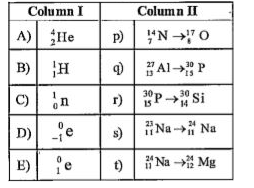Match the Column I giving particles with the reaction involving these particles (one or more) in column II.
 Solution in Malayalam
Solution in Malayalam
A- p, q B-p C- q, s D- t E- r
Topper's Solved these Questions
- NUCLEAR CHEMISTRY BOOK - BRILLIANT PUBLICATIONCHAPTER - NUCLEAR CHEMISTRY EXERCISE - LEVEL-III (Statement Type)
5 Videos
- NUCLEAR CHEMISTRY BOOK - BRILLIANT PUBLICATIONCHAPTER - NUCLEAR CHEMISTRY EXERCISE - LEVEL-III (Linked Comprehension Type)
11 Videos
- NUCLEAR CHEMISTRY BOOK - BRILLIANT PUBLICATIONCHAPTER - NUCLEAR CHEMISTRY EXERCISE - LEVEL-III (Numerical type)
6 Videos
- NITROGEN COMPOUNDSBOOK - BRILLIANT PUBLICATIONCHAPTER - NITROGEN COMPOUNDSEXERCISE - LEVEL-III (Linked Comprehension Type)
9 Videos
- P-BLOCK ELEMENTSBOOK - BRILLIANT PUBLICATIONCHAPTER - P-BLOCK ELEMENTSEXERCISE - LEVEL-III
50 Videos
Similar Questions
Statement 1 :In a nuclear fission process, the total massof fragments is always greater than the original nuclei.
Statement 2 : Difference in the mass due to fission of a heavy nucleus is converted into energy according t mass - energy conversion.
View SolutionA sample contains 10−2 kg of two substances A and B with half lives of 4 and 8 sec repsectively (Given that atomic mass of B is twice of A ).
The mass of A and B left after 16 second is :
View SolutionIn the following distintegration 23892U→20682Pb+ ........ , number of β- particles emitted is
View SolutionMixture of two isomeric amines (C2H7N)A and B was treated with benzene sulphonyl chloride and NaOH and ether were added. Two layers were separated. Ethereal layer containing A on acidification followed by distillation generates A . Aqueous layer containing (B) followed by acidification and distillation generates (B)
Compound in ethereal layer is in the form
View SolutionWhich of the following is the correct statement
View SolutionMatch the items in column I with those (one or more ) given in column II .
View SolutionMatch the items in column I with appropriate items (one or more ) of column II.
View SolutionMatch the items in column I with appropriate items (one or more ) of column II.
View SolutionMatch the items in column I with appropriate items (one or more) in column II.
View SolutionEntries of column I are to be matched with one or more entries of column II.

View SolutionEntries of Column-I are to be matched with entrices of Column-II. Each entry of Column-I may have the matching with one or more than entries of Column-II

View SolutionMatch Column-I with Column-II :
Column-IColumn-II(1) Positive acceleration(a) Speed of particle decreases(2) Negative acceleration(b) Speed of particle increases(c) Speed of particle keep on changing
View SolutionMatch the items given in column I with one or more items of column II.
View SolutionMatch the items in Column I with one or more items of Column II.

View SolutionEntries of Column-I are to be matched with entrices of Column-II. Each entry of Column-I may have the matching with one or more than entries of Column-II

View SolutionMatch the Items given in column I with one or more items of column II.
View Solution
